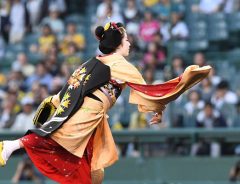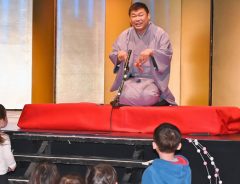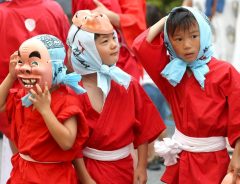
Source: © JAPAN Forward
Niigata’s ‘Giant Kite Battle’: A Story of Retaliation Turns Into A Festival Tradition
- Source:
- © JAPAN Forward
- Tags:
- JAPAN Forward / kite / Niigata Prefecture / Shirone / tako
Related Article
-

[FUJI ROCK 2019] Japanese Duo Glim Spanky Raise Their Game
-

[Kimono Style] International friendship and style showcased in FashiComm
-

Tokyo Michelin Guide 2019: Onigiri Gets Bib Gourmand Status!
-

[Hidden Wonders of Japan] A Maiko Does the Ceremonial First Pitch at Koshien Baseball Stadium
-

Yanagiya Tozaburo Introduces ‘Rakugo’ to the World
-

Tenkawa Village in Nara: The Sacred Location of ‘Shugendo’


Senol Hasan, for JAPAN Forward
Three hundred kilometers west of Tokyo, in the heart of Japan’s Niigata Prefecture, lies Shirone. It is a modest city with a yearly festival that is quite unique — even for Japan.
In early June every year, Shirone hosts its annual “Giant Kite Battle”
(...)
The northward current of the river, combined with the northern winds, plays a significant role in getting the giant kites up in the sky. But it’s the teamwork of the participants and their competitive spirit that make the kite battle such an exciting event to watch.
(...)
The origins of the festival date back to Japan’s Edo period, when new walls were built along the banks of the Nakanokuchi River in Shirone to help prevent flooding. It is said that a local kite on the east side (Shirone) of the river accidentally crashed onto a rice field on the west side, causing significant damage to some crops in the process.
The locals on the west side of the river were outraged by this and chose to retaliate by crashing kites of their own onto the Shirone side of the river. It is not clear how this retaliation turned into a yearly tradition. Yet, remarkably, we continue to enjoy the battle over 300 years later.
Battle Over the Nakanokuchi River
The battle itself consists of two teams, one situated on either side of the Nakanokuchi river. Both teams start by charging down the riverbank while holding the ropes to their giant kites, pulling them into the air.
© JAPAN Forward
Once the kites are airborne, the participants try to get their kites to clash over the Nakanokuchi River, taking advantage of the northward winds as well as the river’s current. When the kites connect, the battle is on.
As the kites clash, both teams begin to pull their ropes vigorously in a game of tug of war. The tug of war gets everybody on all sides of the river fired up and leads to chants of wasshoi, wasshoi, as the participants engage in battle.
© JAPAN Forward
The battle continues until one team’s rope breaks, leaving a clear winner and loser. However, this was not the case in 1932’s giant kite battle, as the tug of war lasted over four hours until nightfall and there was no choice but to end the match in a draw.
Once the winners are declared, they celebrate by chanting banzai in jubilation, while the losing team get to work on preparing a new kite for the next battle. When the final battle is over, an exhilarating fireworks display is held along the river for everyone to enjoy.
(...)
Written by Japan ForwardThe continuation of this article can be read on the "Japan Forward" site.
Niigata’s ‘Giant Kite Battle’: A Story of Retaliation Turns Into A Festival Tradition